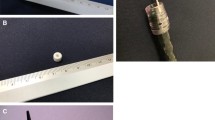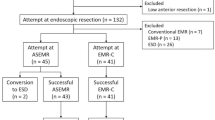Abstract
Background
In recent years, studies have demonstrated that magnetic anchor-guided endoscopic submucosal dissection (MAG-ESD) is feasible and safe and may facilitate the treatment of all difficult lesions. However, the major problem with MAG-ESD is the inability to deliver the magnetic anchor to the gastrointestinal tract without withdrawal or reinsertion of the endoscope. Therefore, our team developed a magnetic anchor that could be easily inserted through the biopsy channel, facilitating ESD traction and evaluated its effectiveness and safety.
Methods
The study was conducted between October 2020 and June 2021 at The Second Affiliated Hospital of Harbin Medical University, China. One hundred and twelve patients with colorectal tumors treated with ESD were divided into two groups for historical control comparison. A channel-placed magnetic anchor (CPMAG) group and a control group consisting of patients who had conventional ESD without adjuvant traction. The rate of en bloc resection and resection with tumor-free lateral/basal margins (R0 resection), dissection speeds, procedure time, intraoperative bleeding and perforation complications, and postoperative follow-up were compared between the two groups, so as to evaluate the clinical effect and safety of the new magnetic anchor.
Results
The en bloc resection and R0 resection rate with CPMAG-ESD were slightly higher than with conventional ESD but this was not statistically significant. The median dissection speeds with CPMAG-ESD were higher than with conventional ESD, but the difference was not statistically significant. Intraoperative bleeding and postoperative complications with the CPMAG-ESD were less than with conventional ESD, but this was not statistically significant. The median operating time was shorter with CPMAG- ESD than with conventional ESD (24.5 min [range 15.8–66.5 min] vs 39 min [range 29–58 min], p = 0.024), and this difference was statistically significant.
Conclusions
The new magnetic anchor-guided ESD technique appears to be a feasible and safe method for treating early colorectal tumors with en bloc resection, with improvement of the submucosal visual field, and less adverse events.


Similar content being viewed by others
Data availability statement
The date that support the findings of this study are available from the corresponding author upon reasonable request.
References
Oka S, Tanaka S, Kaneko I et al (2006) Advantage of endoscopic submucosal dissection compared with EMR for early gastric cancer. Gastrointest Endosc 64:877–883
Fujishiro M, Yahagi N, Kakushima N et al (2007) Outcomes of endoscopic submucosal dissection for colorectal epithelial neoplasms in 200 consecutive cases. Clin Gastroenterol Hepatol 5:678–683
Toyonaga T, Man-i M, Fujita T et al (2010) Retrospective study of technical aspects and complications of endoscopic submucosal dissection for laterally spreading tumors of the colorectum. Endoscopy 42(9):714–722
Matsuzaki I, Hattori M, Yamauchi H et al (2020) Magnetic anchor-guided endoscopic submucosal dissection for colorectal tumors (with video). Surg Endosc 34(2):1012–1018
Imaeda H, Hosoe N, Kashiwagi K et al (2014) Advanced endoscopic submucosal dissection with traction. World J Gastrointest Endosc 67(7):286–295
Kobayashi T, Gotohda T, Tamakawa K, Ueda H, Kakizoe T (2004) Magnetic anchor for more effective endoscopic mucosal resection. Jpn J Clin Oncol 34:118–123
Gotoda T, Oda I, Tamakawa K, Ueda H, Kobayashi T, Kakizoe T (2009) Prospective clinical trial of magnetic-anchor-guided endoscopic submucosal dissection for large early gastric cancer (with videos). Gastrointest Endosc 69:10–15
Zhang X, Liang Y, Li X, Wang J, Li J (2020) Magnetic anchor-guided endoscopic submucosal dissection of rectal submucosal tumor in difficult location. Tech Coloproctol 248(8):893
Matsuzaki I, Isobe S, Hirose K, Marukawa T, Esaki M (2017) Magnetic anchor-guided endoscopic submucosal dissection for colonic tumor. Gastrointest Endosc 855(5):1111–1112
Mortagy M, Mehta N, Parsi MA et al (2017) Magnetic anchor guidance for endoscopic submucosal dissection and other endoscopic procedures. World J Gastroenterol 23(16):2883–2890
Jeon SW, Jung MK, Cho CM et al (2009) Predictors of immediate bleeding during endoscopic submucosal dissection in gastric lesions[J]. Surg Endosc 23(9):1974–1979
Funding
Supported by: Project of the National Training Program on Undergraduate Innovation and Entrepreneurship, 202110226016.
Author information
Authors and Affiliations
Contributions
Conceptualization: XZ; Data curation: XZ, JZ; Formal analysis: XZ, JZ; Funding acquisition: none; Investigation: XZ, JZ, YL, WC, XY, TZ, YL, CH, BQ; Methodology: XZ, JZ, BQ; Project administration: XZ; Resources: XZ; Software: XZ, JZ; Supervision: XZ, BQ; Validation: XZ, BQ; Visualization: XZ; Writing—original draft: JZ, YL, XY; Writing—review and editing: XZ.
Corresponding author
Ethics declarations
Conflict of interest
No conflict of interest exist in the submission of this manuscript, and manuscript is approved by all authors for publication.
Additional information
Publisher's Note
Springer Nature remains neutral with regard to jurisdictional claims in published maps and institutional affiliations.
Supplementary Information
Below is the link to the electronic supplementary material.
Supplementary file1 (AVI 311026 KB)
Rights and permissions
Springer Nature or its licensor (e.g. a society or other partner) holds exclusive rights to this article under a publishing agreement with the author(s) or other rightsholder(s); author self-archiving of the accepted manuscript version of this article is solely governed by the terms of such publishing agreement and applicable law.
About this article
Cite this article
Zhang, X., Zhang, J., Liang, Y. et al. First pilot trial of colorectal ESD guided by a new magnetic anchor for ease of placement. Tech Coloproctol 27, 679–683 (2023). https://doi.org/10.1007/s10151-022-02750-6
Received:
Accepted:
Published:
Issue Date:
DOI: https://doi.org/10.1007/s10151-022-02750-6




